Wilkes University: Judge Max Rosenn: A Man for All Seasons
Written by Tony Mussari, Sr.
Edited by Kitch Loftus-Mussari
Photographs by Kitch Loftus-Mussari
Copyright Mussari-Loftus Associates, LTD 2015
All Rights Reserved
Whatever games are played with us, we must play no games with ourselves, but deal in our privacy with … honesty and truth.Ralph Waldo Emerson
On a cold, damp March afternoon, Kitch and I made a Face of America journey to the campus of Wilkes University. Our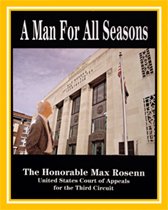 destination was the Marts Athletic Center. Our purpose was to share a re-edited version of our Windsor Park Story, Judge Max Rosenn: A Man for All Seasons with students, teachers and parents who attended the March 26th, Gardner Educational Forum Lecture.
destination was the Marts Athletic Center. Our purpose was to share a re-edited version of our Windsor Park Story, Judge Max Rosenn: A Man for All Seasons with students, teachers and parents who attended the March 26th, Gardner Educational Forum Lecture.
Kitch and I produced this episode from interviews we did with Judge Rosenn in 2004. We wanted to enable the most celebrated jurist in the history of Northeastern Pennsylvania to speak for himself about his life and his legacy. We wanted to highlight his definition of character, integrity, community service and justice. We wanted to enable young people to connect with a man who personifies the characteristics and values of America at its very best.
Several times each year, the Gardner Educational Forum brings  together students, teachers and parents in a community setting to learn about people, places and experiences that will expand the horizons of the students, affirm the important service of teachers, and enable parents to experience the creative and invaluable opportunities Judy and Bob Gardner have been offering their students and
together students, teachers and parents in a community setting to learn about people, places and experiences that will expand the horizons of the students, affirm the important service of teachers, and enable parents to experience the creative and invaluable opportunities Judy and Bob Gardner have been offering their students and 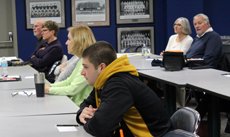 graduates for many years.
graduates for many years.
Judy and Bob have a priceless gift, they make everyone feel like a valued member of their educational family. They create a palpable feeling of belonging and joy when you are with them.
As always, Dr. Robert Gardner started the event with a warm welcome to everyone and an expression of gratitude to the attendees, the participants and the organizers of the event.
Thinking Out Loud
To give structure to this part of the session, our PowerPoint presentation contained 34 slides including 26 informational slides 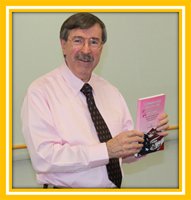 and 8 slides with questions that were designed to stimulate questions and comments.
and 8 slides with questions that were designed to stimulate questions and comments.
We dedicated the lecture to Dr. Dan Kopen, a Wilkes graduate and a well respected surgeon. Dr. Kopen gave Kitch a second chance at life when she was diagnosed with breast cancer. In our opinion, Dr. Kopen is a man for all seasons. Little did we know that one of the participants in the room was a breast cancer survivor and a patient of Dr. Kopen’s. This is what she wrote about the dedication:
I, too, am ever thankful for the kindness and surgical expertise Dr. Dan Kopen afforded me in my life. His kindness and getting me through those days was a onetime gift of a lifetime. I can understand how you place him… in your presentation today.
Of all the questions we asked the audience, these three opened a gateway to the video: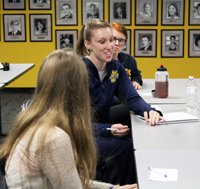
Why should we study the life of Judge Rosenn?
What is character?
What is integrity?
The first question provided a natural transition to this thought. We study Judge Rosenn’s life because values matter…example is important. Studying his life will help us better understand the meaning and application of important values.
To provide context about the meaning of character and integrity, we included a discussion of Sir Thomas More, who, to this day, is the personification of courage, faith, forgiveness, honor, humility, learning, loyalty, patience and thoughtfulness. More was the first person to be honored with the title “A Man for All Seasons.”
Judge Rosenn Speaks
With help from Beth Spencer and Tracy Kaster, we were able set up 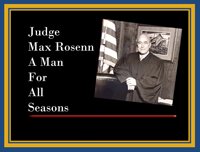 and screen the episode about Judge Rosenn.
and screen the episode about Judge Rosenn.
Sitting in our garden on a beautiful summer afternoon in 2004, the judge spoke eloquently and sincerely about the life experiences which helped him to develop character. In his opinion, character is formed at home, in school and in a religious setting. He believes his character was formed by the time he was 12-years-old. For the rest of his life his character gave him a moral compass that guided his actions in private and public life.
He was unequivocal in his comments about the need for people with character and integrity in all walks of life. People who put the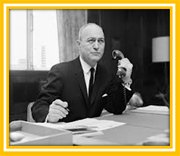 interests of the public they serve above selfish interests of personal gain. He was as critical of CEO’s of major corporations and bankers as he was of elected officials, and rightly so. This was the era of the Enron and the World Com scandals to name but two stories that dominated the news at that time.
interests of the public they serve above selfish interests of personal gain. He was as critical of CEO’s of major corporations and bankers as he was of elected officials, and rightly so. This was the era of the Enron and the World Com scandals to name but two stories that dominated the news at that time.
When Judge Rosenn spoke about his legacy, he emphasized the service he gave to his community after the devastation of Hurricane Agnes in 1972. He said this was one of his finest moments.
He also mentioned his attempt to get equal treatment for women in military service, and his attempt to uphold the claim of a private citizen that public officials like the U.S. Treasurer were obligated to perform a just and accurate accounting of the disbursements of the United States.
Life Lessons
In this section we reviewed Judge Rosenn’s comments 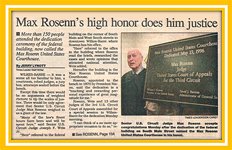 about:
about:
Honesty;
Truthfulness;
Respect for the dignity of the individual;
Morality;
Respect for law and country;
The need to judge people by their character, not their race, social or financial status and the need to learn something every day.
During the Q&A session, an undergraduate student majoring in education who attended the event with her father, who is a teacher,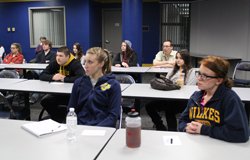 told us that everyday, she and her father sit down to talk about what they have learned that day.
told us that everyday, she and her father sit down to talk about what they have learned that day.
A young, athletic undergraduate told the audience he learned that it is important to be the best person you can be.
A teacher shared this poignant thought: “There’s hope out there. In the classroom, I have to be kind.”
Another teacher shared this hopeful thought: “I come away revived and feeling that it’s going to be alright.”
While looking for a quotation that would summarize our experience  at Wilkes University, I discovered these powerful words of Robert M. Hutchins, president and chancellor of the University of Chicago:
at Wilkes University, I discovered these powerful words of Robert M. Hutchins, president and chancellor of the University of Chicago:
Education is not to reform students or amuse them or to make them expert technicians. It is to unsettle their minds, widen their horizons, inflame their intellects, teach them to think straight, if possible.
That’s a perfect description of what Judy and Bob Gardner do for their students, and how they use their Educational Forum Series to inspire other teachers to do the same for their students.
What we experienced at Wilkes University was a classic example of America at its best.
Thank you, Judy and Bob.
Thank you, Beth and Tracy.
Thank you, Judge Max Rosenn.
Please provide feedback to:
tony.mussari@gmail.com